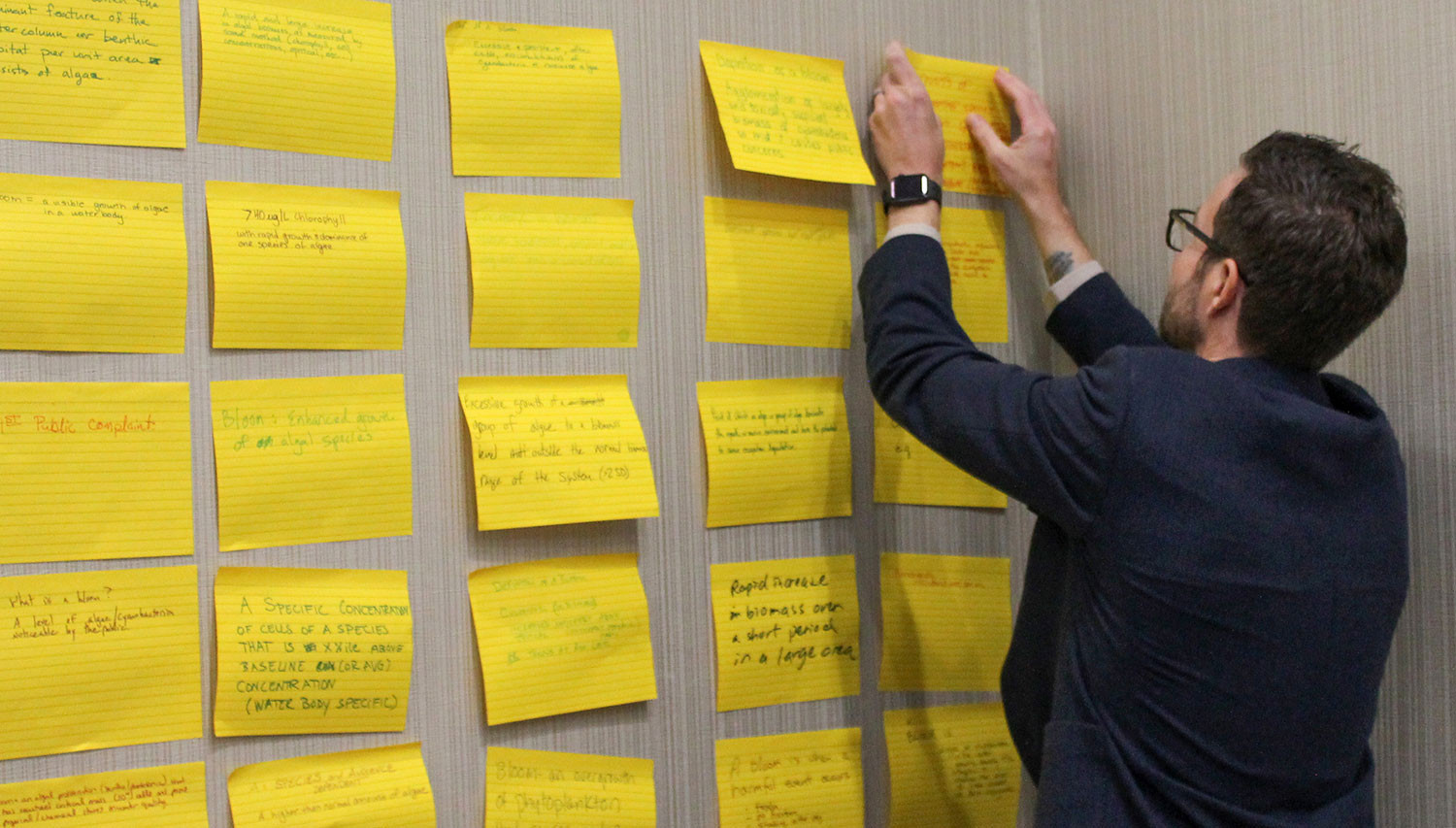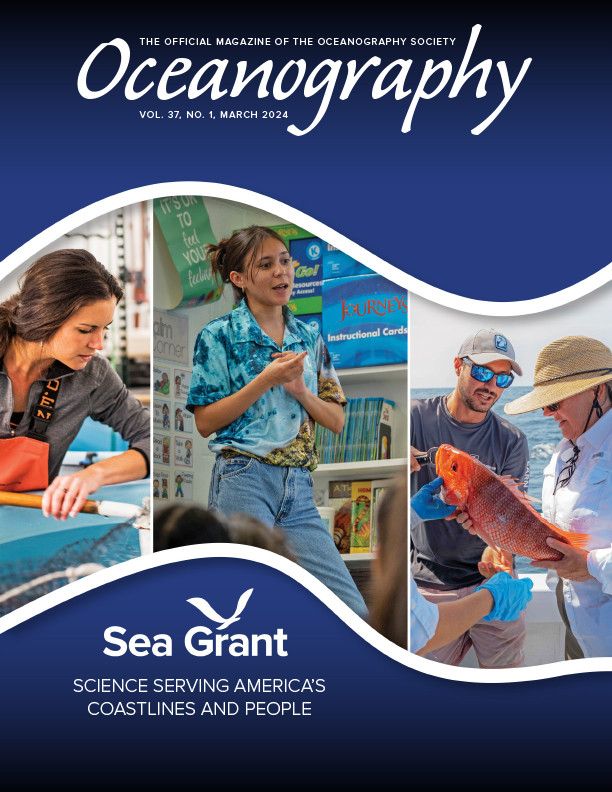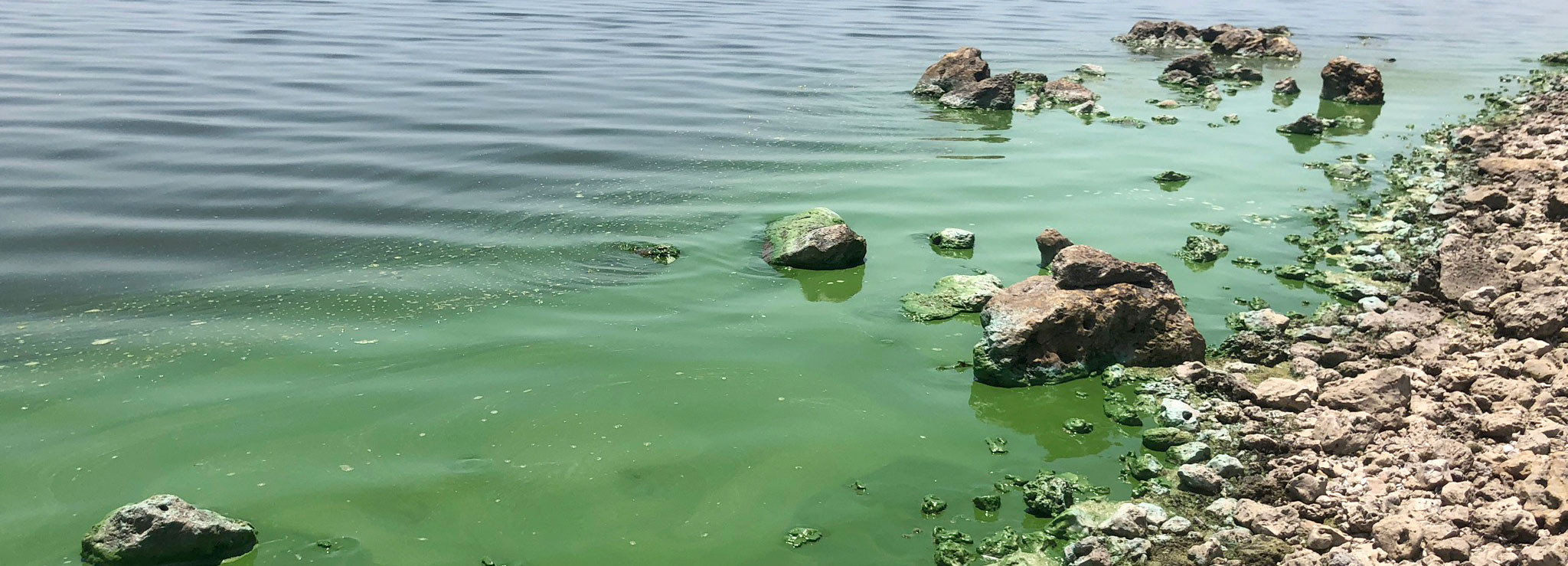Introduction
Algal blooms are the result of the rapid proliferation of algal biomass in water bodies. These blooms become harmful when they cause negative impacts to the environment or human health either through the production of biotoxins or through high biomass events. The state of Florida, with more than 8,400 total miles of coastline, is a hotspot for blooms of harmful algae and cyanobacteria (colloquially referred to as blue-green algae; Heil and Muni-Morgan, 2021).
Two of Florida’s most notable harmful algal blooms (HABs) are red tides in the Gulf of Mexico caused by the marine dinoflagellate Karenia brevis and cyanobacterial blooms (cyanoHABs) dominated by Microcystis aeruginosa in Lake Okeechobee (Heil and Muni-Morgan, 2021; Figure 1). In 2018, these blooms brought local and international attention to the state’s water quality issues. The coincidence, longevity, and severity of these events heightened concern about the probable human, economic, and environmental health impacts. In response, Florida’s governor declared two states of emergency to provide necessary response, recovery, and mitigation resources to impacted counties. Executive Order 19-12 established, among other things, a Blue-Green Algae Task Force (BGATF) under the direction of the Florida Department of Environmental Protection (DEP) and reinstated the Florida Fish and Wildlife Conservation Commission’s (FWC) Harmful Algal Bloom Task Force (HABTF) (F.S. 379.2271). These task forces were charged with providing technical expertise to enhance understanding of the causes of these blooms and to provide recommendations for reducing the adverse impacts of cyanobacterial and red tide blooms, respectively.
Effective management and mitigation of HABs requires an understanding of the causative species as well as a complex suite of factors that drive bloom initiation, maintenance, and termination. For example, nutrient enrichment has been implicated in fueling cyanobacterial blooms in freshwater systems globally (Bonilla et al., 2023); however, the link between anthropogenic nutrients and red tides is more tenuous. Acknowledging and understanding the differences and drivers of these harmful algae is essential for efficacious water management decisions. Successful bloom management is further complicated by the state’s management regime, which involves four different state agencies. Watershed-scale activities at local and regional levels, including land-based activities, nutrient inputs, and local policies, further confound management efforts. These complexities led one task force member to declare that they were “trying to manage a problem they did not fully understand.”
The scientific community has a responsibility not only to conduct robust research but also to effectively transmit and communicate research results to help inform policy and management decisions (Lubchenco, 1998). The Florida Sea Grant College Program is a partnership between Florida’s State University System, the State of Florida, and NOAA. Florida Sea Grant supports applied collaborative research, education, and outreach and is recognized statewide as a reliable source of science-based information. In response to the 2018 blooms, Florida Sea Grant convened a forum of HAB scientists and managers to assess the current state of the research for K. brevis and M. aeruginosa blooms. The Florida Harmful Algal Bloom State of the Science Symposium (HABSOS), held in August 2019, was intended to foster consensus among the growing HAB research and management community within Florida (Krimsky et al., 2019). Following the success of the 2019 Symposium, the BGATF asked Florida Sea Grant to convene a follow-up symposium. The Blue-Green Algae State of the Science Symposium II (BGASOS II) was held in May 2023. Per the request of the task force, BGASOS II focused specifically on cyanobacteria, but expanded the scope beyond M. aeruginosa and Lake Okeechobee to assess cyanoHABs across the state and across the freshwater-to-marine continuum.
Symposium Planning
Both symposia benefited from steering committees composed of individuals from academia and the state and federal agencies responsible for HAB management in Florida, including members from the state’s task forces. The HABSOS committee included five members from FWC, DEP, Florida Department of Health, NOAA, and academia. The BGASOS II committee included members from the same institutions plus two additional members from the South Florida Water Management District and the US Army Corps of Engineers Engineer Research and Development Center. For both symposia, the steering committees identified the goals and ideal outcomes, which ultimately led to the content and process development described below. Attendee participation was by invitation only, to ensure diverse perspectives and buy-in across various institutions and agencies.
HABSOS
Seventy-five researchers representing 27 unique institutions participated in HABSOS. The goals of the two-day 2019 HABSOS Symposium were fourfold:
- Facilitate information exchange and networking opportunities among Florida’s harmful algal bloom scientists.
- Assess the current state of knowledge for Florida HABs with a focus on Karenia brevis and Microcystis aeruginosa.
- Identify data gaps and prioritize research needs for moving the state of the science forward.
- Facilitate better public outreach and communication from the scientific community.
Symposium sessions addressed five major aspects of HAB research including: (1) bloom initiation, development, and termination; (2) prediction and modeling; (3) detection and monitoring; (4) mitigation and control; and (5) public health.
Each session included invited presentations, followed by facilitated group discussions that produced the content for the consensus statements. Consensus statements were framed as what we know, what we think we know, and what we need to know relative to the bloom species and focus area. Research priorities were identified, grouped, and ranked using a voting software tool (supplementary Table S1).
BGASOS II
More than 50 individuals representing 20 institutions including academia, government, non-profits, and industry participated in BGASOS II in 2023. The goals of the two-day symposium were to:
- Identify what progress has been made since HABSOS, determine what knowledge gaps still exist, and prioritize new research needs to inform and improve cyanoHAB management in Florida.
- Efficiently share updates on new findings and ongoing efforts to ensure that best practices are being employed statewide and that ongoing efforts are not being duplicated.
The first goal was addressed during five sessions that followed the same research themes as the 2019 symposium. Each session consisted of lightning round presentations that covered new or ongoing research or management efforts and a Q&A panel followed by group facilitated discussion. Symposium attendees presented what they had learned over the last four years and identified new research gaps and priorities. These were developed into consensus summaries for each session. Research and management progress is reported below under What We’ve Learned Since 2019. We also present a list of the top three ranked research priorities for each theme.
The second goal was addressed through breakout groups according to the symposium’s five sessions (Figure 2). Participants were guided in identifying best practices for methodologies, effectively communicating across academic and management silos, and reducing duplication and preventing redundancies in research. They were also prompted to identify any social science research gaps and priorities.

FIGURE 2. Blue-Green Algae State of the Science Symposium II (BGASOS II) activity demonstrating deliberative process for consensus building. > High res figure
|
What We’ve Learned Since 2019
Drivers
While much of the existing research and management has focused on M. aeruginosa, new research methodologies show that cyanoHABs are more diverse and are composed of numerous cyanobacterial taxa. This is supported by satellite imagery that can detect cyanobacteria when Microcystis is not present. Spatiotemporal assessments show that bloom forming genera differ across waterbodies. Each taxa appears to have distinct drivers, so it is important to understand which bloom-former occurs when, where, and why (Krimsky and Staugler, 2023).
Research Priorities - Top 3
- Understand the factors that contribute to initiation, persistence, severity, and decline of cyanoHABs, and identify drivers, including climate change effects.
- Develop nutrient stoichiometry and understand nutrient sources.
- Understand fundamental biogeochemistry and bloom dynamics, and determine the factors that regulate the timing of blooms.
Prediction and Modeling
Due to its size and influence, new and existing efforts have focused on Lake Okeechobee. Several new models are designed to improve understanding of bloom dynamics in the lake and to support development of short-term and seasonal bloom predictions. The existence of multiple models strengthens our predictive capabilities and provides an opportunity to determine what might be triggering a bloom. These models can be scenario driven but can also be used for short- and long-term forecasts. As model accuracy is tightly linked with the multidisciplinary input features, improvements in data or external models for physical and biogeochemical processes are also needed.
Access to existing data sets is critical for model success. As models are developed, data needs increase and become more specific. Modeling products must not only identify when and where blooms occur but also why, so that management or mitigation measures can be implemented. Model validation is critical to ensure they work for the application intended. Scientists and tool developers must collaborate from the beginning, and the decision-makers who will be using the product should be engaged throughout model development (Krimsky and Staugler, 2023).
Research Priorities – Top 3
- Develop operational short- and long-term forecasts of blooms using multiple model ensembles.
- Collect regular nutrient load (internal and external) data and capture nutrient budgets that include nutrient sinks other than traditional phytoplankton.
- Improve the comparability of satellite imagery with discrete and in situ sampling and create a better explanation of satellite imagery for the lay audience.
Detection and Monitoring
Florida’s cyanoHAB surveillance and response program is responsible for protecting public health by identifying waters where cyanobacterial bloom conditions exist and limiting the public’s exposure to unsafe water conditions. Program personnel collect water samples and analyze them for cyanotoxin producing species or toxin presence. Results are posted by health agencies and on the publicly accessible Protecting Florida Together algal bloom dashboard as quickly as possible to limit public exposure to toxins. In addition to sampling specifically for cyanoHABs and toxins, water quality information such as chlorophyll and nutrient content is collected to build a data set that can be used by researchers to better understand bloom dynamics.
Detection and monitoring require a collaborative effort. Sample collection, preparation, and analysis methods have significant effects on what is detected and reported. Small modifications may bring great benefits. Enhanced monitoring efforts and technologies have improved the state’s ability to respond to these events, but data gaps remain. It is still difficult, with a reasonable level of accuracy, to predict the timing and toxicity of blooms, despite knowing where they are likely to occur. Although knowledge about them is essential for protecting public health, the mechanisms that drive cyanotoxin production in a bloom are still poorly understood (Krimsky and Staugler, 2023).
Research Priorities – Top 3
- Conduct comprehensive and strategic routine non-bloom monitoring, in addition to event HAB response sampling; include ambient monitoring and pre- and post-intervention monitoring.
- Conduct taxonomic and nutrient assessment monitoring; collect additional field samples for microscopy.
- Conduct long-term quantitative monitoring of complete phytoplankton assemblages alongside routine water quality monitoring.
Mitigation and Management
Effective mitigation and/or management of cyanoHABs requires proper identification of the harmful species, and knowing whether they produce toxin, if it creates a health risk, and if it fixes nitrogen. Determining the feasibility of treatment measures in different systems, such as scale-up and costs, is also important. Ultimately, any cyanoHAB mitigation tool should be safe and effective as well as cost-effective. Accomplishing this involves exploring the chemical, ecological, biological, and socioeconomic ramifications of any such tool. Despite new advances in this field, there is no silver bullet for cyanoHAB management and mitigation; consequently, it is important to communicate clear expectations to the public.
Implementation of any cyanoHAB mitigation project requires a clearly defined goal and pre-determination of the criteria for effectiveness. Both short- and long-term evaluation should be part of the process to measure efficacy. As new algal control methods are developed and deemed effective, establishment of a central database to catalog and assess the effectiveness of alternative technologies would aid in identifying successful approaches. Ideally, this database should operationalize the site-specific parameters for each technology, recognizing that these technologies cannot be tested in every water body (Krimsky and Staugler, 2023).
Research Priorities – Top 3
- Holistically improve nutrient source management to reduce nutrient pollution by improving understanding of nutrient cycling and bioavailability, nutrient sources and sinks, phosphorus content of reclaimed water and biosolids, and phosphorus recovery at water reclamation facilities.
- Develop scalable HAB mitigation tools that are economically feasible.
- Develop new technologies for sediment nutrient mitigation.
Public Health
Understanding human and animal cyanotoxin exposures and illnesses can help to prevent future illnesses. Since 2019, many partnerships have been formed to standardize information for key stakeholders, including human and veterinary health care providers and the public. Partnerships provide multiple sampling data sources to trigger automatic public notification on the Protecting Florida Together website. Additionally, several surveillance and epidemiological studies are underway to assess the effect of short- and long-term exposure to cyanotoxins on humans and domestic animals, but results on long-term impacts are still years away. In the absence of clear results, recent efforts have focused on outreach to and education of the public health community, including a partnership with the poison control center. Current outreach efforts also focus on increasing awareness of emergency response personnel regarding the possibility of cyanotoxin exposure and educating the public about cyanobacteria events. In-person veterinary education and online educational tools for veterinarians and pet owners have also been developed. Efforts have also focused on enhancing the resources necessary to support these long-term longitudinal cohort studies. Since 2019, methods have been developed to test for the presence and levels of toxins in human tissue, and a biorepository of blood and urine samples during bloom and non-bloom conditions has been established.
Research Priorities – Top 3
- Understand short- and long-term health effects from exposure to cyanotoxins; include veterinary diagnostics.
- Develop clearer diagnostic criteria for health care and veterinary professionals.
- Characterize human exposure to cyanotoxins, with attention to vulnerable and compromised populations.
Best Practices
Methodologies
In general, universal standardization of methodologies and parameters is impractical, as the specific research and management question should drive data collection. Nevertheless, the fundamental best practices for data collection revolve around ensuring quality data and the availability of metadata. Data are only valuable if they are both trustworthy and understandable. When suitable, the community should establish standard data and metadata requirements, while accommodating technological advancements and data evolution.
Sharing and Preventing Duplication
Overall, fostering increased dialogue across research and management groups, along with collaboration across federal and state agencies, is crucial. Traditional avenues of information sharing, such as focused symposia and workshops, for example, BGASOS II, play a vital role in keeping the broader cyanoHAB community informed. These activities facilitate the sharing of successes, challenges, and failures, and allow open and candid discussions in a safe environment.
Funding agencies need to take a more active role in preventing duplicative grant opportunities and redundant research. To facilitate this, a mechanism for interagency communication should be established. Federal entities should evaluate state-level initiatives, and reciprocally, state-level assessments should consider federal actions. Early and frequent collaboration between researchers and managers is essential in the funding process.
There is widespread enthusiasm for establishing a community of practice and a central repository curated by state funders for the cyanobacterial research and management community. This would serve as a connected data network and a hub for discovering and reporting ongoing research projects (e.g., funding agency, grantee, and project information). The format would prioritize accessibility and operate as an open-source resource.
Social Science Research Needs
A recurring theme emphasizes the need to enhance communication with the state’s diverse target audiences. Social science research is essential to understanding the decision-making processes of these audiences, determining effective ways to frame concepts that resonate with various stakeholders, and contributing to the development of tailored behavior motivators based on specific audience characteristics.
Economic impact assessments are needed to (1) better understand the cost of cyanobacteria blooms to the state of Florida, (2) improve how costs are communicated to the public, and (3) get or maintain support for cyanoHAB research and management projects.
Impacts
Success of the symposia can be attributed to steering committee guidance and knowledge of the participants. Their ownership of the process and information presented allowed for immediate use and transfer. The HABSOS document was used by the HAB Task Force; it provided the foundation for the identified research priorities and was the only work referenced in their consensus document recommendations to the state legislature (Krimsky et al., 2019; HABTF, 2020). These priorities drove the HAB Grant Program that funds projects that address the HABTF priority recommendations, and provided legitimacy and justification for members of the research community who were applying for grant funding. According to the findings of BGASOS II, 67% of all cyanoHAB research priorities listed in 2019 were addressed by research projects during the following four years (Table S1).
The value of the symposia is best demonstrated by the BGATF’s request for BGASOS II four years after HABSOS. During evaluation and breakout sessions, BGASOS II participants recognized these symposia as important opportunities for networking and forging collaborations, preventing duplication, sharing successes as well as failures, and conducting candid dialogue in a safe space.
Ultimately, relationships with government agencies, 19 universities and institutions within the state, and various stakeholder groups places Florida Sea Grant in a unique position within the HAB community. Viewed as a reliable source of science-based information, Sea Grant has a distinct role in moderating these complex issues, facilitating consensus, and presenting recommendations for moving the science forward to mitigate the impacts of Florida’s harmful algal blooms.
Acknowledgments
We would like to thank the members of the steering committees: E. Cooley, L. Flewelling, L. Glenn, M. Michalsen, A. Reich, B. Rosen, R. Stumpf, and D. Whiting. C. Ellis provided facilitation for HABSOS. Funding for BGASOS II was provided by DEP and the National Sea Grant office. Travel support for HABSOS was provided by NOAA NCCOS and Florida Sea Grant.



